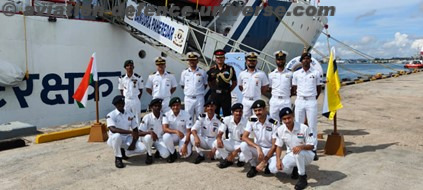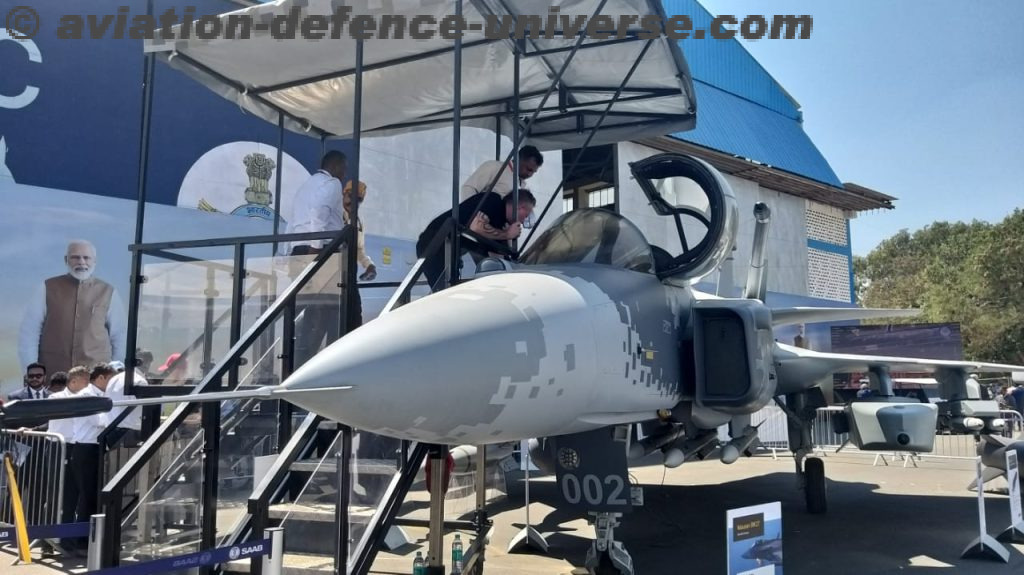By Sangeeta Saxena
Bangalore. 13 February 2023. The queue outside the full scale mockup of Gripen E at Aero India, anytime of the day for sitting in the cockpit seems endless. The Swedish fighter aircraft is definitely catching eyeballs.
The Gripen E is an updated version of the Gripen C/D, and its design emphasizes versatility, cost-effectiveness, and interoperability with other NATO countries. It has advanced electronics, avionics, and sensors, and it can carry a wide range of weapons and systems. The Gripen E is designed to be a multirole fighter, capable of performing air-to-air, air-to-ground, and reconnaissance missions.
It is designed to be highly maneuverable and agile, with a focus on air defense and air-to-air combat. Its small size and advanced control systems make it highly effective in close-in air-to-air combat.The Gripen E is generally considered to be a more cost-effective option. This is due to its smaller size, simpler design, and lower maintenance requirements.
The company has always projected Saab Gripen E as a highly capable fighter aircraft that could be a suitable option for the Indian Air Force (IAF). The fighter is designed to be highly effective in air defense operations, with a focus on air-to-air combat. This makes it well-suited to support the IAF’s needs for a modern air defense platform. The Gripen E is designed to be a cost-effective option, with lower procurement, operating, and maintenance costs compared to other fighter aircraft. This could be particularly appealing to the IAF, which is seeking to modernize its fleet while also controlling costs.
Saab has a history of offering technology transfer and co-production opportunities to its customers, which could be beneficial for the Indian aerospace industry. Gripen E supply chain involves a number of companies from various countries that contribute to the production of different components and systems of the aircraft.
Here are some of the companies that are part of the Gripen E supply chain. General Electric (GE) of the United States, which supplies the F414G engine. Honeywell International, also of the United States, which provides the aircraft’s avionics systems. European aeronautics company Airbus, which is responsible for the aircraft’s cockpit and displays
Swiss company RUAG, which produces the aircraft’s landing gear and other structural components. German electronics company Rohde & Schwarz, which supplies the aircraft’s communication and navigation systems. Brazilian aerospace and defense company Embraer, which is a partner in the production of the Gripen E for the Brazilian Air Force.
This is not an exhaustive list, as there are many other companies involved in the production of the Gripen E, both from Sweden and from other countries.
The Saab Gripen E is primarily designed as a tactical fighter aircraft, which means it is intended for use in short-range, fast-paced air-to-air and air-to-ground missions. It is equipped with advanced sensors, weapons, and avionics systems that enable it to carry out a wide range of combat operations, from air superiority and ground attack to reconnaissance and electronic warfare. However, the Gripen E also has some strategic capabilities, as it can be used for long-range missions and can be equipped with a variety of weapons and sensors to perform a range of tasks. For example, it can be used for air policing, air defense, and maritime patrol, among others.
Saab Gripen E fighter jet has been ordered by three countries: Sweden, Brazil, and Switzerland. Sweden was the first country to operate the Gripen E, and it has ordered a total of 60 aircraft to replace its aging fleet of Gripen C/D aircraft. Brazil has ordered 36 Gripen E aircraft to modernize its air force and enhance its air defense capabilities. Switzerland has ordered 30 Gripen E aircraft to replace its fleet of aging F-5 Tiger fighter jets. It is worth noting that other countries have expressed interest in the Gripen E, and additional orders may be placed in the future.
“From the outset, Gripen E was designed for ease of maintenance that secures higher availability than its competitors. Gripen E can operate in extreme climates and from dispersed and unprepared road bases or airstrips. It takes less than 20 minutes with only a limited number of ground crew and equipment to refuel and rearm Gripen for an air-to-air mission, which ensures rapid re-engagement. With low maintenance requirements per flight hour, Gripen E spends less time on the ground and more time in the air,” say the company officials.
Furthermore Gripen is equipped with the MBDA Meteor missile for BVR combat, and the range of the Meteor exceeds by far any current US BVR missile and it is not yet integrated onto US fighters. This provides Gripen with an advantage in BVR combat. And if launched upon, the Gripen E EW-suite including countermeasures will support evading and surviving an incoming hostile missile.
Wingspan: 8.6 meters
Length: 14.1 meters
Height: 4.5 meters
Maximum takeoff weight: 16,500 kg
Engine: General Electric F414G, with a maximum thrust of 22,000 pounds
Maximum speed: Mach 2 (2,470 km/h)
Service ceiling: 15,240 meters
Range: 1,300 km with external fuel tanks
Armament: 1x 27 mm Mauser BK-27 cannon and up to 8,000 kg of weapons, including air-to-air missiles, air-to-ground missiles, and bombs
Avionics: Advanced sensor suite, including radar, infrared search and track, and electronic warfare systems.























































































































